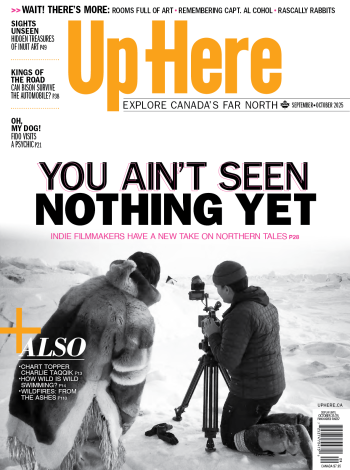Since time immemorial, the art of beading has been passed down from mother to daughter in the North’s Indigenous communities. Mariah MacDonald, a relative of mine from Champagne and Aishihik First Nation in the Yukon, first learned how to bead through school, starting in kindergarten. MacDonald keeps those lessons in mind as she works on her projects, but what she creates differs from the floral patterns originally taught to her. Some of those works include beaded Baby Yodas and the Mandalorian.
“I like the creative freedom to be able to bead characters from shows. Flowers and more traditional beading is beautiful but being able to create something fun is what usually gets me to bead,” she says. Though it takes plenty of time, detail, and effort to create each item, it often pays off in the end when people show interest in her work and sometimes offer to buy the items from her.
Although the craft has remained the same over generations, the patterns and style of today’s beaders are more attuned to the styles and attitudes of a whole new generation of Dene who have often travelled extensively across Canada, and maybe even the world. Within Denendeh, there have been more artists expressing themselves through, but not limited to, beadwork, embroidery work, moose hair tufting, fish scale art, tanned fish skin, and porcupine quill work. Many things can be made such as moccasins, mukluks, necklaces, earrings, pendants, wall art, key chains and even lighter cases. The materials too have changed. These days, the needles often come from stores, glass beads are sold by the gram and thread from the bundle. Whereas a while back, the materials used were from animals. Needles were created from bones, thread from sinew. Hides and furs became clothing. Fish scales and moose hair were used for decoration. Today more clothing has become decorative, with beading outlining flowers, eagles, and people.
I’m one of these young people who are modernizing the craft. I admit I lean more toward beaded jewellery than traditional crafts—although I can still bead moccasins. Beading today is expressed differently from person to person, but in this new generation I find many of us bead things that aren’t traditionally done. I learned the skill from my mother, grandmother, and aunties, as well as distant relatives through camps. I strive to express myself through my beading whether it be through small flower earrings or precisely designed fringe earrings. Many people have purchased my work from the unceded Algonquin territories to the unceded territories of the Coast Salish. The most popular items I have made are the small flower earrings and cloud earrings.
The topic of ‘traditionally made crafts’ means different things to a vast majority of people, but for the most part it refers to what the crafts stem from. In the case of Denendeh, most items have flowers and leaves that are common across the board in moccasins, gloves and art work.
Modernized beading is anything but that and the techniques being used are beginning to change. While some artists stick to the techniques they originally learned, others are changing it up. That might be by using glue or less expensive thread, like floss. Artists may repurpose unused necklaces for findings or use a tracer tool to transfer patterns. In making the craft more accessible to Indigenous people, it’s not limited to what you may have learned from relatives such as doing something only one way. It also provides more creativity in the tools and how you can manipulate them in order to transfer the image in your head onto the the art, whether by gluing down strings of beads in a pattern or not using a pattern, or simply skipping a stitch. Regardless of how they get there, many Indigenous people are using art to reconnect with their traditions. And that connection is paramount.
“Bringing traditions into more modern practices makes them easier to access for some,” says MacDonald. “It can also act as inspiration as you’re not fully tied down to traditions.”










